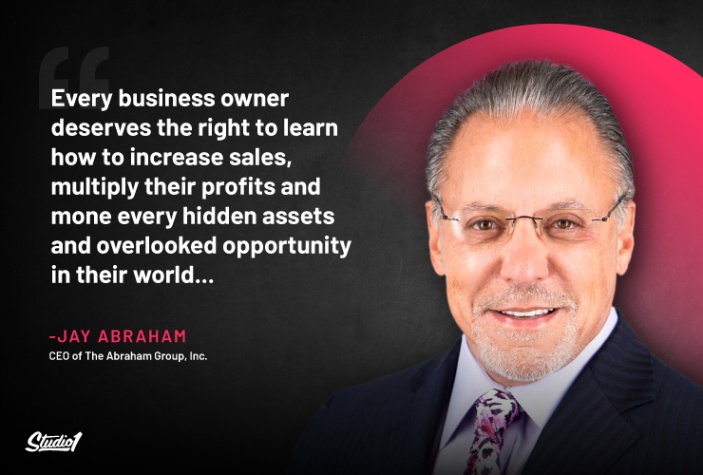
Jay Abraham is one of the world’s great business strategists. He’s an original thinker and a genius in helping his clients find ways to transform their businesses. His endless curiosity to learn everything about everything and his obsession with transforming business results through better strategy make him a great speaker with a wealth of knowledge that he shares generously.
In a recent presentation I attended, Jay revealed that…
There are really only 3 ways to grow a business:
1. Get more buyers.
2. Get your existing buyers to buy more frequently.
3. Charge more for your products or services.
Doing this well requires discipline, strategic thinking, and TAKING ACTION!
Do business differently
Jay Abrahams has some core principles for growing your sales that are all based on thinking and acting differently.
These principles are:
- Look for ways to solve your prospect’s problem differently from your competitors.
- Do what your competitors aren’t doing.
- Explain the reason why you’re better than your competitors.
- Look for ways to partner up and collaborate with other businesses that supply your target customers.
Do what the others AREN’T doing!
Finding new customers and more sales is about thinking differently. It’s about finding new ways to solve your potential customer’s problems. Some examples are:
- Harvey Norman challenged traditional models of “lay-by” by offering finance options to allow customers to “take their goods home today, then pay later!”
- Australia’s Commonwealth Bank went full circle from ATMs and branches with minimum tellers to concierge service at the front of the store
- Interface, an Australian commercial carpet company, leased carpet tiles that could be individually replaced as a service instead of selling broadloom that needed to be replaced entirely every 5 years
Studio1 Design provides an unlimited design service ‘DesignerOnTap’ instead of charging by the hour or by the project. This helps the business look unique and congruent at every touchpoint with its customers.
Do something new to find new ideas
Working out how to zig while your competitors zagging can be tough. What we now know about human perceptions is that what you know, limits what you see. It’s a whole lot easier to do something different if you expand what you know about your business, your competitors, and other businesses that also serve your customer.
So finding and building a new marketing strategy starts with:
- Defining explicitly what “everybody knows” about your business and your market – so that you can ask “Where is this NOT so?”
- Actively extend what you know so that you’ve got access to new ideas and new strategies
You can achieve this by…
Researching and quantifying your own processes
What are you doing that’s really effective? The 80/20 principle is basic to most human activities – and it’s not always 80/20. Some organizations can spend 95% of their time doing things that don’t really matter to the business – and only 5% doing the things that add value to their customers and create sales
Researching your competitors
Make sure you know what they are doing and how they deliver to their customers. You can’t do something different if you don’t know what’s being done
Researching your wider industry
Find out what the latest trends are and what’s happening on the fringes of your industry. By doing this, you can stay ahead of the game! A simple research exercise you can do from home is opening up Amazon…pay attention to the chapter headings on the contents page and then read the reviews
Talking to your existing customers regularly
Find out their pain points and new ways of solving their problems. By simply starting a genuine and curious conversation, you can uncover so much more about your client base than guesswork could ever achieve
Finding out who else serves your customers
Find out where you have different strengths that complement each other. Explore whether there is a joint venture or alliance you can form. For example, Jay shared a case study of one of his clients in China where a motorcycle maker with a great product but a small distributor network linked up with a lawnmower company that needed a wider product range but had a big network
Know YOUR business
Too many businesses don’t know what part of what they do actually works, and they don’t know how to MEASURE it.
There are two fundamental factors to know in your business:
- The Lifetime Value of your customers (i.e. What is their profile?) and;
- Your customers’ purchasing cycles (i.e. What do they buy regularly? When do they buy it? Why do they buy it?)
When you know the LTV (Life Time Value) of your different customer profiles, you can focus on finding more good customers. You’ll know where your marketing spend can deliver the best ROI.
Paired with information on your current customer’s purchasing cycles, you can explore how to make other valuable offers that keep them interested.
Take Action, Don’t Wait for the Competition
“Do or do not do – there is no TRY.” – Yoda
Do something! Anything… Look for things to do that are different. Test and measure to see what difference your actions made – and learn from what didn’t work.
Just start with one action, don’t try to do lots of things at once. Keep your focus and track what works. There are lots of small adjustments you can make to increase revenue. Everyone that you do will multiply the results of the others, and over time you’ll build BIG results.
There are many small adjustments you can make to increase revenue. Put them all together and these 10-15% increases will multiply into a lot better performance!!
Beware technology for technology’s sake
Technology for technology’s sake, or for “cost reduction” can cost you money and even customers.
When the big banks ripped out all the tellers from their branches and closed branches, they lost business.
Use technology intelligently – use it to find ways to deliver new solutions to your customer’s problems. Netflix delivered movies fundamentally differently from VideoEasy. Uber delivers car trips differently from taxis.
If you’re ready to do things differently and take your website in a new direction, book a free consultation with us.
We’ll show you how we will take your website and brand to the next level, so you can have a bigger impact on your audience.
No pressure, no obligation – just a friendly conversation about what you want your website to do and whether we can help.
















